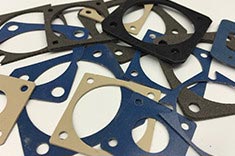EMI Shielding Products
- Custom Gasket Fabrication
- Connector Gaskets
- Bonded O Ring
- Custom Gaskets
- Conduct-O-Knit Knitted Wire Mesh
- Conduct-O-Seal Combo Gasket
- Conduct-O-Elastomer
- Conduct-O-Seal Oriented Wire in Silicone Gasket Material
- Conduct-O-Mesh Tape
- Conduct-O-Foam
- Conduct-O-Bond
- Optical Filters For Electronic Displays
- Shielded Vent Panels
- ESC Board Level Shielding
- 300 Series
The Most Common EMI Shielding Materials and Applications

The silent threat of electromagnetic interference (EMI) often looms large in electronics. This interference can disrupt the regular function of devices and systems. Engineers have turned to various shielding EMI materials tailored to specific needs and applications to counteract this.
- Pre-Tin Plated Steel: The Cost-Effective Solution - One such material is the cost-effective pre-tin-plated steel. Known for its proficiency in shielding against lower frequencies, it primarily handles the kHz range extending to the lower GHz range. The addition of a tin coat offers the dual benefits of rust and corrosion resistance and equips it with distinctive low-frequency shielding capabilities. However, while it serves devices operating within its frequency range with aplomb, its capabilities might be stretched thin for high-frequency EMI shielding needs.
- Copper Alloy 770: The MRI Compatible Shield - Another popular choice in the EMI shielding arsenal is the Copper alloy 770, also referred to as Nickel Silver. This alloy, a concoction of copper, nickel, and zinc, has earned acclaim for its notable resistance to corrosion. It's especially valued in environments requiring shielding in the mid-kHz to GHz range. A standout feature of this alloy is its permeability of 1, making it a top pick for settings like medical facilities where MRI machines operate and the interference of magnets is undesirable.
- Copper: The All-Rounder - Then there's copper, a material revered for its unparalleled effectiveness in thwarting magnetic and electrical disturbances. From sophisticated hospital equipment to everyday household electronics, copper's presence is ubiquitous. While it might command a steeper price than some of its counterparts, its exceptional conductivity justifies the investment. Nevertheless, when budget constraints are at the forefront, alternatives might need to be considered.
- Aluminum: Lightweight and Conductive - Aluminum, with its impressive strength-to-weight ratio and commendable conductivity, is another contender in the EMI shielding space. While its conductivity approaches 60% of copper's, aluminum does have its Achilles' heel – it's more prone to corrosion and oxidation than other metals. This vulnerability makes it a double-edged sword, particularly suited to scenarios where weight is a significant concern, like aerospace, but perhaps less ideal in environments where its susceptibility to corrosion might be a disadvantage.
- Beyond Metals: Films, Foils, and Foams - Beyond these primary metals, the world of EMI shielding also boasts films, foils, foam, and even silicone. For instance, engineers often lean on EMI shielding films or foils in commercial settings. Then there's the carbon foam, which, despite its lack of metallic components, is an efficient shield within the 100 MHz to 20 GHz range, impressive with its flexibility and resilience. When imbued with metal, Silicon transforms into a conductive EMI shield that's malleable and resistant to environmental extremities.
The realm of electronics is rife with challenges, with EMI being a notable one. However, engineers are well-equipped to tackle this issue thanks to a suite of shielding materials. The key lies in discerning the application's specific requirements and selecting the material that aligns best, ensuring that devices and systems remain undisturbed and function at their optimal best.



